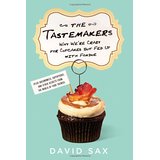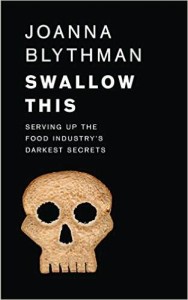
I have recently read The Tastemakers; Why We’re Crazy for Cupcakes but fed up with Fondue by David Sax.
Here’s a very long quote from this book (p282-286) which encapsulates its intention, and sums up the whole issue:
At their worst, food trends can be annoyingly shallow. They may start out as individual expressions of imagination, but ultimately they become victims of a herd mentality. One day everyone in your life is eating Greek yoghurt, and you’re not sure how it happened. In the case of trends like the cronut they literally attract stampeding herds of humans. It is easy to view the culture of trends as the vapid expression of a society obsessed with materialism, as insubstantial fads. We dine out for entertainment, watch hours of food being cooked and eaten on television, and plan road trips to taste the latest hot meal. Food has become fashion, chefs are hailed as rock stars, and photos of the latest dishes are our art. At the same time we live in a world where millions are starving or malnourished, and not just in distant poor countries but also within walking distance of our homes. In the United States alone more than 16 million children don’t have reliable access to food. They’ve never heard of cronuts or chia seeds or the ceviche from Ricardo Zarate’s kitchen, and they don’t give a shit that you just posted a review of the top-twenty hottest food trucks in DC on your blog. These people wait in lines and dig through the trash for their next meal, not for some sense of culinary thrill-seeking.
It is hard to contemplate this reality when you’re walking the halls of the Fancy Food Show, having so many culinary creations thrust at you that you can hardly swallow them fast enough. While writing this book I was often tempted to blame the ramen burger, the bacon explosion, or the chia-flavored Greek yoghurt cookie for the sad absurdity of this problem, not to mention the much prettier but sometimes compelling problem: I was tired of hearing about food trends…..
Food trends bring us happiness. You can groan all you want about how cupcakes are “over” as a trend, but if I placed a cupcake in front of you, you would still peel back the folds of its paper cup with the same eager anticipation you had when you were a kid at a birthday party……….
Food trends are for everyone. They may originate as speciality items, available only in select cities for a high price and long wait, but eventually the nature of all food trends is democratic…..
Food trends can also deepen and expand our culture beyond the plate. The success of Anson Mills grains as done more to further Glenn Roberts’s goal of preserving the Carolina Rice Kitchen than any political campaign or charitable plea ever could. The quality and flavour of his grits and rice may propel their trendiness, but their ultimate cultural impact has resulted in a revived interest in southern history, traditional cooking, heritage ingredients, and farming practices that are spreading across the South and around the world. Trends also bring the kitchens of that world together…………
All of these trends created economic growth…….
With that economic might, too, comes the possibility of even more change. If enough people get behind a way of eating, policy with eventually follow.
Over the last few decades most of the food sold to us has become more processed, giving rise to particularly devastating health consequences such as obesity, heart disease, and diabetes…… health problems related to overeating were entirely unknown twenty years ago. This shift, unfortunately, is also a food trend, and it is a hell of a lot more impactful than any hot pastry of the moment. Trends like these aren’t easily diverted or slowed down; they are powerful and change the way we eat on a biological level. You cannot litigate them out of existence. They require a shift in the opposite direction with equal momentum and force to unseat them. The only thing that can do is a countertrend.
To come to this conclusion, Sax had to trek around to events, meet lots of people in the food industry, get first-hand knowledge, and read reports.
It started with Sax looking at the cupcake trend, for which customers would actually stand in a queue, for hours, to buy them. And probably Instagram their friends about it. Like many others, he seemed amazed that these people didn’t have a life, or thought queuing for a cupcake is a life. He wasn’t afraid to be humorous about people’s excesses and tastes, or his own.
As you can see in the excerpts above, these food trends are not all worthless junk food items with poor nutrients. Glenn Roberts at Anson Mills helped preserve the old Carolina rice breeds, and works with farmers, food historians and chefs to recreate the Carolina Rice Kitchen. And he now sells these ancient grains online.
Another interesting food trend is the food truck, as it gives diners a cheap introduction to different ethnic cuisines, which some Americans and Australians are not used to.
He’s a journalist and his writing style is very readable. It’s not a resource for cupcake recipes, ramen burgers, chia, kale, bacon, or sriracha; it’s about the influencers, and marketing of these products. Foodies and those with an interest in food matters, including trends, would enjoy this book.

 This book was chosen for the Slow Food Sydney Book Group. We can’t say we enjoyed it, but everyone thought it was scary because the various food safety authorities seem to wave through food products as safe.
This book was chosen for the Slow Food Sydney Book Group. We can’t say we enjoyed it, but everyone thought it was scary because the various food safety authorities seem to wave through food products as safe.